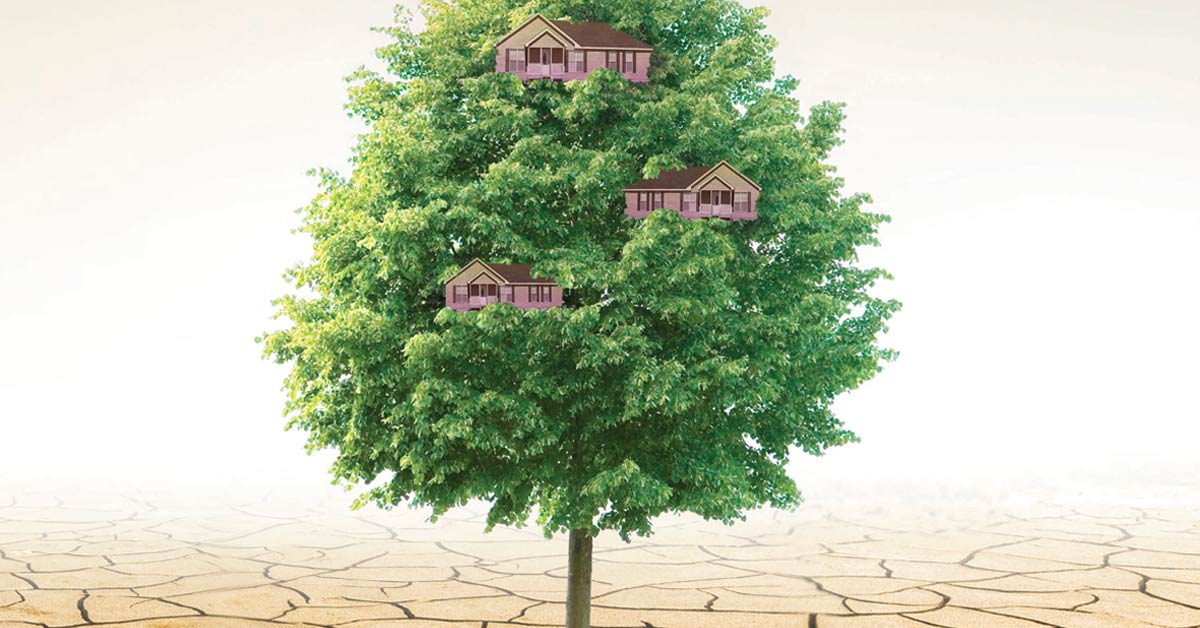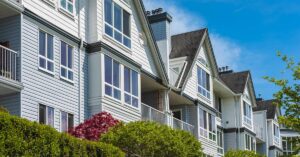Throughout the COVID-19 pandemic, commercial-property owners and investors have seen the hospitality, retail and office sectors grapple with the impact of working and staying at home. Yet commercial real estate transactions are still closing in the multifamily-housing sector. In particular, manufactured-housing communities (MHCs) have shown resiliency during the pandemic.
As the growth in housing costs continue to outpace wage increases, manufactured housing is one of the fastest-growing housing segments. It is, in many locations, the only form of truly affordable detached housing available in the U.S. As a result, MHCs are thriving despite the economic downturn and represent an area of opportunity for real estate finance professionals.
The manufactured-housing sector is the only major commercial real estate asset class that has not experienced a year-over-year decline in net operating income in any year since 2000, according to research from Green Street Advisors. Mobile-home parks (MHPs) and manufactured-housing communities — which have distinct regulatory definitions — were performing well for commercial real estate investors before the COVID-19 pandemic, and that has not changed.
Professional MHP and MHC owners provide safe, secure, quality housing at affordable prices, which is in high demand in the current environment. Municipalities, zoning boards and neighborhood associations, however, have shown great resistance to allowing new communities to be developed or expanded. With the exception of Florida, there have been few manufactured-home parks developed in recent years. This lack of new development has benefited existing properties. Well-located and maintained communities can be upgraded and improved, and their value is rising in today’s market.
Park owners are upgrading their properties by buying new manufactured homes and providing financing for homebuyers, or by leasing the houses with an option to purchase. These communities provide true affordable housing. Residents get a new home with a combined house-and-pad rent or mortgage expense of $850 to $1,000 per month, which is much less expensive than the equivalent rent for an apartment with the same square footage.
When the properties are comprised of newer housing stock, new roads and common amenities, such as pools and playgrounds, these communities are now valued in the 5% capitalization rate range, which is comparable to well-kept apartment properties. There will always be new apartments developed, but zoning restrictions typically limit the number of new MHCs.
For investors, the barrier for entry also is much lower than with other asset classes. Since residents own their homes, park investors are only responsible for landscaping, common-area maintenance and utility repairs. Long tenancy tenures equate to low turnover rates, too. This further adds to the investment appeal.
Over time, lenders and investors alike have come to recognize the stability and strength of this asset class, as demonstrated by strong occupancy, solid rent growth and low default rates. Pre-pandemic, investors were pursuing MHCs and MHPs at historically low cap rates, while lenders aggressively offered historically low interest rates.
These communities have lasting power. While other real estate sectors have been battered by the pandemic, 2020 was a strong year for MHC financing. Many parks are located in secondary and tertiary markets outside major cities, and residents typically have not suffered layoffs to the same degree as those in major urban areas. Furthermore, most properties enjoy a rent-collection rate in excess of 90%.
When the properties are comprised of newer housing stock, new roads and common amenities … these communities are now valued in the 5% capitalization rate range, which is comparable to well-kept apartment properties.
Capital sources
There are many sources of financing for mobile-home parks and manufactured-housing communities. Agency lenders, providers of commercial mortgage-backed securities (CMBS), debt funds, credit unions and banks have continued to finance transactions for these communities, although agency lenders tend to be preferred. Private lenders also are active in most states.
Traditionally, Fannie Mae and Freddie Mac were the lenders of choice for MHC investors, especially after Freddie entered the sector. In 2019, for instance, Fannie Mae provided $2.5 billion in MHC financing, while Freddie Mac provided $1.4 billion, according to a Wells Fargo report.
Other traditional financing sources have included CMBS and life-insurance companies. CMBS lenders, however, typically expect wider interest rate spreads, as well as a more costly process and more restrictive loan terms than other lending sources.
Life-insurance companies have typically focused on lower loan-to-value (LTV) transactions and have been highly selective with regard to asset quality. Also, life-insurance companies tend to prefer larger transactions of $10 million or more.
Some banks have a good understanding of mobile-home parks from a credit perspective and, in the past, have offered aggressive loan terms. Others, however, view the asset class as special-purpose real estate that warrants more conservative terms and constrained LTV ratios. Some lenders require personal guarantees rather the nonrecourse options that investors naturally prefer.
Not surprisingly, the COVID-19 pandemic has made banks more conservative and pushed many large banks to the sidelines. Bank borrowers can expect LTV ratios in the 50% to 70% range rather than the pre-pandemic levels of 65% to 80%. The typical debt-service-coverage ratio required is likely to be close to 10%.
Creativity required
Although multifamily transactions in general have continued throughout the pandemic, the underwriting has become somewhat more conservative. The quoted fixed interest rates, however, have been significantly lower compared to historical rates.
The largest banks and life-insurance companies have pulled back from this subsector, but other lenders have become more interested. If their hospitality and retail exposure is minimal, credit unions, smaller insurance companies and banks, private lenders, debt funds and portfolio lenders are still making loans on manufactured-housing communities.
Despite the strong fundamentals of the MHC sector, securing financing nonetheless requires some creativity and looking beyond the banks. Recent mobile-home park transactions have not been business as usual and have tended to involve unique borrowers and property profiles.
One novel transaction entailed funds from a California-based lender collateralized by a portfolio of 71 single-family home loans in Lafayette, Indiana. The transaction was the originator’s first non-recourse single-family rental portfolio loan and its first with the California lender. Similarly, a $15.5 million bridge loan for a mobile-home park, which included 265 rental homes in the Southeast U.S., was provided by a nonbank funding source.
The continued demand for manufacturing housing can’t be denied. As the most-affordable nonsubsidized housing option in many markets, factory-built housing provides shelter for roughly 7% of the U.S. population. Low supply and strong consumer demand have driven stellar fundamental investment performance for the sector in recent years. One measure of the sector’s investment strength is that manufactured-housing real estate investment trusts (REITs) have outperformed the broader REIT index over the past several years.
Although the downturn caused by the pandemic may have an impact on housing prices, manufactured housing will continue to be among the most-affordable options. Equally important, supply will continue to be constrained. Manufactured-housing stock has grown at an annual rate of 1% or less over the past decade, while zoning has become increasingly restrictive in some areas during this time. Therefore, expanding an established community or creating a new one can be quite difficult.
What commercial mortgage brokers and investors must bear in mind, however, is that the pandemic and economic downturn has altered the dynamics of the financing landscape. Capital sources are available, but closing a transaction will require adopting a creative approach and looking beyond the usual suspects. ●
Author
-

Ben Kadish is the president and founder of Maverick Commercial Mortgage Inc. and is a mortgage banking professional with more than 37 years of experience. Kadish’s primary focus is funding commercial mortgages ranging from $1 million to $40 million for income-producing properties.
View all posts







